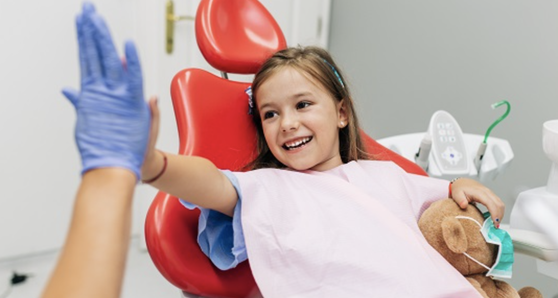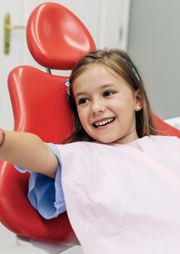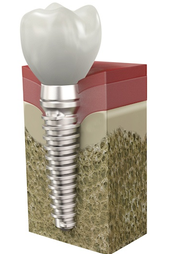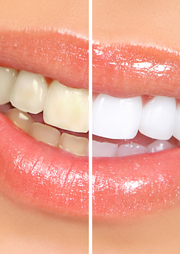Regular check-ups from a very early age and preventive treatment (oral hygiene sessions, sealing...) ensure that your children will have a healthy smile. Frequent check-ups also help identify problems in their early stages, when damage is still minimal. If needed, x-rays can be used to verify the development of permanent teeth or locate decay that is not visible to the naked eye.
If you wish to find out more, several books are available, such as "Mamma che denti!" by Guido Benedetti (Mandragora Editore – in Italian).
When should I take my child to the dentist for the first check-up?
Parents should take their children to the dentist for their first check-up after 1 year of age, unless the paediatrician suggests a dental check-up at an earlier stage. After that, children should be checked by a paediatric dentist every 6-12 months in order to monitor oral hygiene, diet, and the development of the entire mouth.
When a child goes to the dentist for the first time, it is best to avoid treatment. Trying out the chair with cartoons or music playing in the background will make for a pleasant moment to be experienced without any fear. If the child is relaxed and the situation is appropriate, the first check-up may be the perfect opportunity to count the number of milk teeth, while the child observes what is going on inside his/her mouth through a mirror.
An early check-up with a paediatric dentist is important to build up a relationship between the child and the dentist based on trust and comfort, which will be the basis for future check-ups.
How can decay be prevented?
Plaque constantly builds up on our teeth and is the main cause of tooth decay. Plaque is a soft white-yellowish film made up of bacteria which combine with sugar and starches and damage the enamel of our teeth, thus causing decay.
Correct oral hygiene to remove plaque and food debris from a child’s teeth, in combination with a healthy diet with limited consumption of very sugary foods, is the most effective way to prevent caries.
What is baby bottle tooth decay?
Baby bottle tooth decay is caused by milk and, above all, by sugary drinks (herbal tea, fruit juice...) drunk from the milk bottle, which remain in contact with the child’s teeth for a long period (for instance, overnight). So, avoid sugary liquids and honey to make your child fall asleep!
Should I give my child fluoride tablets?
Yes, fluoride can be taken by the mother during pregnancy and breastfeeding and it is also advisable to start fluoride intake before the teeth erupt.
Fluoride supplements are sold as drops or tablets. Drops are particularly suitable for newborns, as they can be mixed with a little water in the milk bottle. Do not dissolve the drops in milk, as this would decrease their absorption.
As soon as the child is old enough, switch to tablets, which should be kept in the mouth between the cheek and gum until they dissolve. The tablets should be taken in the evening before sleeping and after brushing of the teeth, in order to keep a high concentration of fluoride in the mouth for a long time. The appropriate daily dose depends on the age of the child, on the fluoride content of public water, as well as on the amount of fluoride from other sources, such as the child’s diet and toothpaste used.
When should I start bushing my child’s teeth?
Start brushing your child’s teeth with toothbrush and toothpaste as soon as the first tooth appears.
Choose a toothbrush specific for children with soft bristles and a very small head. Small children tend to play with their toothbrush and bite it: let them do that, as brushing their teeth should become a game for them. Replace the toothbrush regularly when the bristles become worn.
Use a children’s toothpaste with a flavour that appeals to your child, so that brushing will become a pleasant habit, but make sure to avoid ingestion of large quantities because children’s toothpaste often contains fluoride. Children should be able to brush their teeth autonomously after the age of 6-7; before that, they rarely possess the appropriate manual skills, so the parents can step in when the children have finished doing their own brushing.
What is the purpose of tooth sealing?
Sealants are a safe and painless method to protect children’s teeth from decay. Sealants are resinous coatings applied to the chewing surfaces of the back teeth. The sealing material creates a hard protective barrier that keeps food and bacteria away from the grooves of the teeth, where they would cause decay.
Sealants are suitable for all children, whether prone to decay or not. They are most effective in preventing caries if applied within 2 years of tooth eruption and their integrity must be checked every 6-12 months. SEALANTS CAN REDUCE DECAY BY 70-80%. The sealant remains on the tooth for a few years and does not need to be removed, as it wears away in time but, if it is no longer in place two years later, it should be reapplied.
What should I do if my child has broken a tooth?
Dental traumas are becoming increasingly common both in early childhood and as children grow older.
Traumatic events responsible for damage to the teeth can occur at home (stairs, wet floors, sharp corners), at school, while playing sports (hitting, elbowing, falling), and during free time activities (cycling, walking in a forest or on the beach, roller-skating, skateboarding, using a kick scooter....).
In November 2012 the Italian Ministry of Health published the "NATIONAL GUIDELINES FOR THE PREVENTION AND CLINICAL MANAGEMENT OF DENTAL TRAUMA TO INDIVIDUALS IN THE DEVELOPMENTAL AGE ".
According to these guidelines, in case of dental trauma, the child must be kept calm, any blood residue must be eliminated, and the damage must be carefully assessed (type of tooth involved, possible fractures along the chewing ridges, mobility or partial extrusion of the tooth, avulsion, possibility of recovering a tooth fragment or saving the whole tooth).
Avulsed teeth stand a good chance of being replanted if they are kept for a maximum of 2-3 hours in a wet environment (physiological solution, milk, or saliva). Moreover, healing is more probable if replanting, temporary splinting to other teeth (2-4 weeks), and subsequent check-ups are suitably performed by a specialist.
In any case, a strict check-up plan must be followed to avoid complications.
If this event occurs at a very early age, it may be a perfect opportunity for a first dental inspection and the planning of regular check-ups in the following year, which may also contribute to reassuring the child about regaining a perfect smile. (From "NATIONAL GUIDELINES FOR THE PREVENTION AND CLINICAL MANAGEMENT OF DENTAL TRAUMA TO INDIVIDUALS IN THE DEVELOPMENTAL AGE", Italian Ministry of Health, November 2012).
How can I avoid traumas during physical activity?
Several traumas to the teeth occurring while playing games or sports can be prevented or minimised using a mouthguard, which can be made to measure in our practice.
What are space maintainers?
Space maintainers are devices designed to keep the space left if a milk tooth is lost too early, so that the permanent tooth can erupt naturally in the appropriate space. Space maintainers can be made of steel and/or resin and can be fixed or removable. When the permanent tooth is ready to erupt, the maintainer used to keep the space can be removed so that the new tooth can erupt naturally and completely.









